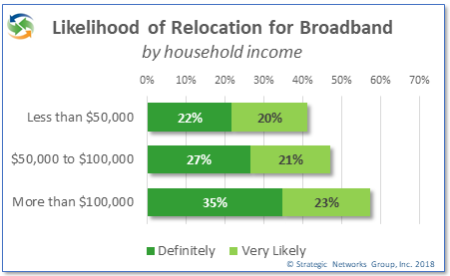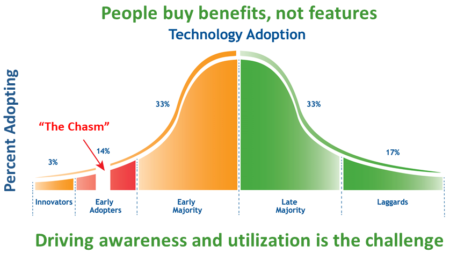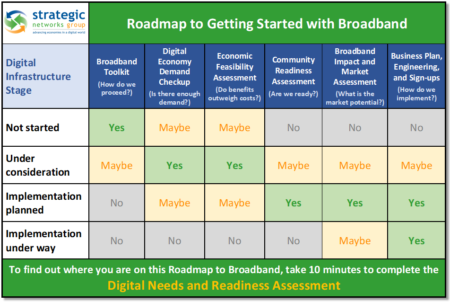
With more and more funding for broadband – for example, the US’s $100 billion through the American Jobs Plan, or Canada’s Universal Broadband Fund – unserved and underserved localities should be encouraged by these positive and significant steps. However, there are a number of uncertainties:
- Will the broadband funding legislation actually pass? – intact? – and when?
- Government investment in broadband will not cover all the unserved and underserved areas – so who will get the funding?
- How long will the application process take to define? – what will be the terms and conditions? – and when will funds actually be available to localities?
- Will localities be able to over-build existing incumbent networks – even if they are not future-proof? – if no, to what extent will digital infrastructure fully cover the locality? Will all have access to online health, education, workforce development, smart community services, etc.?
- Do local leaders understand why some individuals and businesses do not take advantage of what broadband is already available? Does the locality have strategies and eligible funding to bridge digital divides, to bring everyone online, and to maximize community benefits from broadband investments?
SNG recommends that localities proceed with their own and/or private investment to build digital infrastructure and to not lose any additional time in bridging broadband gaps. No locality can wait to catch the next wave of broadband funding. COVID-19 has accelerated the urgency that digital infrastructure be available to all – now.

In parallel to developing their own broadband investment solutions, localities should apply for broadband funding once the application process is available. If their application is funded, great – then use public funds to support and expand a healthy competitive broadband marketplace that connects all local premises with digital infrastructure that can provide needed redundancy by being available to multiple providers.
For those localities that know they have broadband problems, but struggle to find a path forward – especially when potentially large investments are needed … there is an alternative strategy. Localities need to answer key questions on how to solve their broadband needs:
- Where are the broadband gaps and where are the greatest needs in our locality?
- How is the lack of broadband affecting our businesses and residents?
- What technologies make sense to address our broadband gaps? Are we committed to solutions that meet current and long term needs? What investments are needed?
- Will our broadband problem be solved by the private sector service providers? Are there areas of interest and opportunity for private sector providers for accelerating network build-out to our unserved and underserved areas?
- Based on identified broadband gaps and needs, potential for accelerating private sector build-out – what is the roadmap for potential broadband projects?
SNG can help in this process with our Broadband Technical Opportunities Roadmap to answer these questions and empower localities to develop their own strategies so they can effectively engage with service providers and other partners to take action. Broadband is too important to your community’s prospects not to own your digital future.
 Investing in community digital infrastructure is a low-risk impact investment with steady returns – and a solid alternative to traditional investments where there is increasing volatility (stock markets), uncertainty (e.g. oil and gas industry), or marginal yields (investment grade bonds). Private investors and patient capital are part of the solution for communities.
Investing in community digital infrastructure is a low-risk impact investment with steady returns – and a solid alternative to traditional investments where there is increasing volatility (stock markets), uncertainty (e.g. oil and gas industry), or marginal yields (investment grade bonds). Private investors and patient capital are part of the solution for communities.
Patient capital enables pivoting to an economic case for investing in community digital infrastructure, capturing new revenues from local economic growth by growing the local economy through broadband and digital transformation. Revenue from increased local economic activity is captured through additional subscriptions (higher take-rates), higher value-subscriptions, and value-added services.
An economic case for investing in digital infrastructure is what communities and the broadband industry have been waiting for – now it is time to execute. The COVID-19 pandemic has sharpened the argument that the case for broadband is not just economic – but existential. Elected officials, local decision-makers, and community leaders have to understand that:
 Investing in broadband cannot be put off. Leaders can no longer wait for their replacement to take on a broadband initiative. Even if they do not have the experience, know-how, or time left in their term – their community needs reliable broadband now.
Investing in broadband cannot be put off. Leaders can no longer wait for their replacement to take on a broadband initiative. Even if they do not have the experience, know-how, or time left in their term – their community needs reliable broadband now.- The need is real and growing —the escalating transition of work, healthcare and education to a digital platform means that broadband can no longer be considered a luxury, it is essential to competitiveness and sustainability. Heavily increasing network traffic and burdening networks that were not built for such loads.
- A new norm has emerged — COVID-19 is driving home the reality that gaps in broadband access, quality, and affordability are endangering the very survival of citizens and businesses in communities that do not have digital infrastructure.
Communities seeking better broadband need solutions now. Investors are looking for steady returns. SNG has established an economic case to engage investors and bring private capital to deliver community digital infrastructure, digital transformation, and workforce development.
We start with digital infrastructure for the new economy, which is more than simply fast internet access. Community digital infrastructure is a network platform that connects all residents and businesses (like roads) so that every community member can access and effectively participate in the increasingly online economy. Digital transformation and workforce development increase local innovation and digital inclusion, which grow the local economy and workforce – whose growth further expands the local market for broadband and value-added service revenues for the digital infrastructure network. This virtuous cycle yields indirect community benefits, such as local business retention and growth, new good-paying local jobs, increased local GDP and tax base, increased autonomy and quality of life, among many others.
You have a new way to bring private capital and community digital infrastructure together and get this done.
 As a local leader or elected official, you may need to decide whether or not you need a survey, or a study for your broadband initiative. If the value isn’t clear, or if it doesn’t get you closer to your goal, why spend time and money on a ‘survey’ or another ‘study’? Don’t do it just because another community has.
As a local leader or elected official, you may need to decide whether or not you need a survey, or a study for your broadband initiative. If the value isn’t clear, or if it doesn’t get you closer to your goal, why spend time and money on a ‘survey’ or another ‘study’? Don’t do it just because another community has.
Understand which communities have achieved their broadband goals and how they got there.
If you have areas that are unserved or underserved with broadband, private sector providers have not seen enough of a business case for them to invest. Low density, tough terrain, insufficient take rates to make a business case, etc. are realities that must be overcome and will require more than re-packaging of your market, or expounding on ‘we have a great community’. If service providers have a better return on their investment elsewhere, that is where they will invest.
To get broadband deployed to your unserved or underserved areas there are generally three options going forward – 1) entice a provider to deploy in your area by subsidizing their business case; 2) build your own network to compete directly with other incumbent providers; or, 3) build your own digital infrastructure which multiple providers can then use to provide services (like municipal roads which are built, owned and maintained by the municipality, but anyone can use them).
 Regardless of which option communities choose, elected officials would want to be in the best position to negotiate and to decide the best path forward for their community by understanding the broadband investment options, the market potential, and the community returns on investment (ROI).
Regardless of which option communities choose, elected officials would want to be in the best position to negotiate and to decide the best path forward for their community by understanding the broadband investment options, the market potential, and the community returns on investment (ROI).
As a builder of broadband networks explained, ‘take rates’ and ‘revenue generation’ are really the opposite of what a community wants to achieve. A community needs to focus on the development of a sustainable model that does not restrict, but enables sustainable future growth. What communities nor providers don’t know is what broadband can do to sustain and grow what the community already has, as well as how that growth has been suppressed by lack of or slow broadband investment
For these reasons assessing broadband demand is not a survey, but necessary due diligence on the market potential and choosing your broadband strategy (bringing providers to serve your areas, or building your own) while ensuring the best return for your community.
 We know that providers already have their expected take rates and will use their spreadsheets in developing their own business case. However from SNG’s extensive research, the majority of the community benefits from broadband are off-balance sheet to providers – which means providers under-value their return on investment as compared to community returns on investment (i.e. community benefits). We call this an economic case for investing in broadband – some people call it a government business case. It’s the same reason we have public investment in roads.
We know that providers already have their expected take rates and will use their spreadsheets in developing their own business case. However from SNG’s extensive research, the majority of the community benefits from broadband are off-balance sheet to providers – which means providers under-value their return on investment as compared to community returns on investment (i.e. community benefits). We call this an economic case for investing in broadband – some people call it a government business case. It’s the same reason we have public investment in roads.
For those considering a public-private partnership, if you know that you have a strong market potential (current and future demand) for broadband and value-added services, this will strengthen your position on negotiating how much your community needs invest to make a successful business case. On the other side, if your unserved and underserved areas do not show a strong demand then you may want to limit your risk, or take actions to build up demand. It is also possible that some areas have higher demand than others, which can allow you to be more tactical with the timing and prioritization of broadband deployments.
Data points on market potential inform your investment case for whether you choose to negotiate with an ISP by developing an RFQ or RFI for a public-private partnership, or if you decide to build your own digital infrastructure. We’ve written about this issue in our recent post: Where do we put our efforts to get connected with broadband?
SNG has recently launched the Digital Economy Demand Checkup offering with a regional ISP (who were the ones that requested we do this) and we think it will be of interest to communities everywhere because it:
 Gives local residents and businesses a vehicle to express their need and willingness to sign-up for better connectivity – contact lists for those who want to sign-up can be shared with the provider, finance last mile deployment, inform broadband deployment priorities, etc.
Gives local residents and businesses a vehicle to express their need and willingness to sign-up for better connectivity – contact lists for those who want to sign-up can be shared with the provider, finance last mile deployment, inform broadband deployment priorities, etc.- Provides elected officials with proven tools to collect needed data points to answer the following questions:
- What is the current broadband demand as compared to expected demand from provider’s spreadsheets?
- What is the potential demand that can drive additional revenues for providers, as well as community benefits?
- What are the issues or barriers that need to be overcome to drive demand and meaningful use so that local businesses and residents fully leverage technology?
We are able to address these fundamental investment case issues in a cost effective way with our Digital Economy Demand Checkup. Not only do we identify current demand, but also potential demand and market potential. We don’t know of anyone else that can benchmark demand to increase service provider revenues and maximize local economic impacts. For example, with a municipal service provider we identified a 64% increase in revenues for no additional capital investment. This represents an increase of 47% in Average Revenue Per User (ARPU).
SNG was recently asked by residents from a neighborhood just outside Nashville, Tennessee, where to best put their efforts to get connected with broadband. They have lived in a location for 10 years and it is not serviced with high-speed internet even though they are near where it stops on either end of their community. Asking the incumbent providers in their words “has proven futile” to getting better service. However they have many neighbors who would be interested in better internet service because many have businesses and work from home and they don’t want to move.
At SNG, we understand this challenge, which too many residents and businesses face across North America because of their perceived addressable market, expected revenues vs. cost to service their market, low density, etc. Approaching private sector providers can be ‘futile’ if those providers do not see enough of a business case to invest in your area and when providers have better returns elsewhere.
The challenge to get broadband deployed in unserved or underserved areas is to enable a positive case for investment. Driving awareness and utilization of broadband with local residents and businesses drives local economic growth and community benefits – which makes a case for public investment to bridge broadband gaps.
Two Options Going Forward
There are generally two options going forward – either 1) a public-private-partnership to entice a broadband provider to deploy in your area by subsidizing their business case; or, 2) build your own digital infrastructure which multiple providers can then use to provide services (like municipal roads which are built, owned and maintained by the municipality, but anyone can use them).
Subsidizing a Service Provider’s Business Case
If you choose to subsidize a provider’s business case to bridge their gap between their costs and their expected returns on capital, then local dollars should be used to build infrastructure that the locality owns (like a tower, backhaul fiber, etc.). This retains local ownership and negotiation capability which may be needed if there is poor broadband service because the provider is exercising a market dominant position. Retain ownership and control of your digital future.
In working with providers, there is also the option of conducting a broadband demand assessment to identify people ready to sign-up to new service, as well as assess potential demand for online services. This is local market demand research. Private sector providers are often reluctant to spend their retained earnings on such research, especially if they are unsure there is a business case for them. By quantifying current and potential broadband demand up-front and sharing that with private sector providers, they can apply that data to their business models to see if there is a business case for them that previously ‘flew under their radar’. Having a contact list of people who are ready and committed to sign-up makes that business case for the provider even stronger.
In both these broadband public-private-partnership instances, local funds subsidize one service provider. This may be a tactical, less complicated, and a less involved way for a locality to move forward – who in their right mind would want to take on more work, especially a broadband initiative! However, performance agreements should be negotiated and periodically reviewed to ensure local residents and businesses are getting the broadband they need – and want.
Investing in Digital Infrastructure
The other approach is the locality investing in their own digital infrastructure which is more involved, more complicated, and longer term. But this approach addresses the issue of local ownership and control of essential infrastructure – as with other infrastructure like roads, or electrical where community benefits are significantly greater than a private sector business case. At SNG we call this the economic case for investing in broadband. The example of Ammon, Idaho, proves that it is possible for a locality to own their digital future while also allowing multiple providers to provide competitive, robust internet services that meet the needs of local residents, businesses, and organizations.
Deciding where and how to get started depends on the addressable market of the locality (i.e. broadband market potential), the local champions available to drive the process, the local organizational capacity to support a broadband initiative, and whether local residents, businesses, and organizations (government, education, health) have an understanding and vision of how they can benefit from using online practices. The table below outlines a roadmap to get started with broadband and SNG’s suite of services that have been designed to help you make the right decisions based on your needs and circumstances, no matter what stage you are at in the process.
Where and How to Get Started with a Broadband Initiative
If you are interested in assessing at what stage your locality is in the process of getting broadband – because it is a process – we have the Digital Needs and Readiness Assessment that your local broadband champion can take online. When they completed the 10 minute online survey, a report will be generated and automatically be emailed to them. We developed this tool specifically to help local leaders understand at what stage their locality is and to help them prioritize their community goals and priorities. SNG’s goal with this is to help local leaders make better informed decision on how they can and need to move forward in a way that is pragmatic, clear, and cost-effective.

The broadband lifecycle: demand analysis and pre-planning
By Michael Curri
Much too often broadband initiatives that should be successful end up falling flat – for a myriad reasons. Perhaps they do not get off the ground because of a lack of vision, planning, or leadership. Many fail during the strategy and build-out process as they lack focus and/or sufficient investment of time, energy, and resources. Some initiatives may have been successful building the network but fail because they are simply taking a “we built it – you use it” approach and not driving applications and adoption. And even the most successful broadband projects, with ample utilization and economic and social impact can be perceived as a failure if the outcomes are not measured and reported.
It is for all of these reasons that SNG encourages its customers (and all broadband project managers for that matter!) to design and run their broadband initiative with “one eye on the Broadband Lifecycle.” In this issue of Bandwidth, and the next two, we will be taking a look at 2 of the 6 steps of the Broadband Lifecycle. In this issue: step 1 (identifying gaps, needs, and demand) and step 2 (pre-planning and assessment).
Step 1: Identify gaps, needs, and demand
Before you jump in with both feet (and fistfuls of dollars), ask yourself: does your community need (more) broadband? Is your region’s current infrastructure insufficient when it comes to meeting the needs of your entrepreneurs? If the answer to either question is YES – then the most important task in step one is to determine how a broadband investment can eliminate community shortfalls and create solutions for economic and civic advancement.
Critical here is to identify your community’s specific needs. Don’t make the mistake of simply following any “tried and true best practices” that you think may apply in your territory – as the gaps and needs for one region are not necessarily yours. Don’t scrimp on research in this stage – too often it is feared that research is too slow and expensive – or just unobtainable. However, we know it can be done. Strategic Networks Group (SNG) has for years been helping governments, at municipal, regional and national levels, to best understand where investment will make the biggest impact. [Most recently SNG has helped Alberta (Canada), Michigan, North Carolina, Ohio, and Virginia with a variety of data collection solutions, including e-Solutions Benchmarking.]
Step 2: Pre-planning & assessment
Make sure you have your “ducks in a row” and all of your stakeholders/partners on board before moving forward with the next step (developing a strategy). What do you need to implement a successful broadband deployment? What leadership and partners do you need to achieve your community’s goals? What components need to be included your deployment? Keep in mind that having a well-represented group of invested parties in your community helps create the momentum you need for a wide-reaching, successful project.
Make sure you take into account your community’s assets: each community has both different needs and different strengths – and those strengths will be uniquely leveraged via the broadband-enabled “platform for innovation”. Too often communities take shortcuts. Instead of uncovering what the needed resources are, or how to leverage current efforts to best serve the specific and unique needs of the community, civic leaders race to copy what another community did. [Contact SNG for our numerous case studies in this phase, including work in Miami (FL), Akron (OH), the Canadian provinces of Ontario, Toronto, Manitoba, and Australia.]
No matter where you are on the Broadband Lifecycle, you can turn to us for leadership to help navigate through the challenges and pitfalls of each step, maximizing your project’s economic impact and civic advancement.
Next Month: Steps 3 (e-Strategy & decision to invest) and 4 (Build or expand network capacity).
How to invest wisely – 4 key guidelines
By Doug Adams
Now that you have funding, how can you make sure that your project lives up to the promise that got it funded in the first place? Hundreds of broadband projects are being funded in 2010 – be it from Stimulus or some other funding source – but how many will truly become a community asset that drives economic and social benefits?
Key to making sure your project will have a return on investment with quantifiable outcomes starts with these four guidelines:
- Don’t focus on engineering: it’s all about awareness and adoption;
- Use data to drive decisions before, during, and after the project;
- Create a “platform for innovation”: investing in broadband is NOT just about the financials;
- Frame the benefits, measure them, and promote.
Don’t focus on engineering. It’s all about awareness and adoption.
Broadband planning should start with current and future demand of e-solutions by individual businesses, organizations and households. It is natural to focus on the tangible always – the network build, the nuts and bolts of it all – it is how we’re programmed… to follow a blueprint and build.
But building without utilization is a fruitless (although significant) exercise. It’s the utilization, the applications, and the resulting increased productivity, competiveness and innovation that your network creates that are the reasons for investment. Never lose sight of this. It’s the “off-balance sheet” benefits to the private and public sectors that are key for your broadband initiative to bring community value. And the key to deriving value is, and always will be awareness and adoption. Often requiring campaigns targeted at the individual business, organization and household level.
By always keeping your eye on driving adoption, the public investment will be seen as a successful part of community growth.
Use data to drive decisions – before, during, and after the project.
Broadband planning is part of strategic planning for a community / region. Without an assessment of current utilization, or a vision of what the utilization could be, how can an appropriate network be built?
Make sure you do the legwork (research) to understand what how local businesses need to do to be productive and competitive and how broadband – or better broadband – can help them achieve their goals. Do you have plans for applications that will support needs? What services can broadband support for public institutions? And will the network be able to meet utilization requirements?
Take ownership locally of your region’s future – local stakeholders need hard data and insights to make the right decisions about what kind of community they want to be 5, 10 years down the road – and how broadband helps get you there?
Investing in broadband is NOT just about the financials. It is about creating a “platform for innovation.”
It’s easy to see the immediate benefits that broadband will bring – be it needs that are blatantly apparent or discovered through assessment. What is not always as immediately evident is the long term transformational power of a broadband “platform for innovation.” One needs only to look back ten years to see how the world has changed – and the economic and social benefits that have accompanied this change – when broadband first emerged as a replacement for dial-up.
Looking back through our history, there have been countless – and sometimes unpopular – decisions to make an investment in infrastructure whose benefits would reveal themselves only when it was in place, and for decades to come. Roads, railroads, water and sewer systems, national defense, etc. are all examples of economic drivers that exceeded what could have even been imagined.
The opportunity cost of not having broadband is continued loss of jobs, industry and youth from a community / region – you cannot afford not to have it if you wish to remain relevant and competitive in an increasingly globalized economy.
Only when you stop looking at your broadband project yielding only immediate and finite benefits will you begin to see the true benefits for your community.
Frame the benefits. Measure them. Promote.
While all of the benefits of your network are not immediately measurable – measure what you can – and promote your success! Define success is measurable, tangible metrics – not with philosophical mumbo jumbo.
By defining goals and the criteria for measuring success, it is possible to collect the data needed for short-term return on investment. All public investments require accountability and transparency, so putting in place up-front monitoring and management process maximizes cost-effectiveness of cost-benefit analysis, but more importantly can leverage these processes and tools to maximize local economic and social benefits. Of course SNG can help you with each and every challenge you may have to ensure your community’s network investment has the measurable impacts and long-term benefits you need.
“Measuring community the broadband community return on investment”
Research from SNG and others (as well as anecdotal experience) has convinced most decision makers that broadband is beneficial. This, along with federal funding and increased policy focus, is fueling a growing interest in taking this “broadband is beneficial” understanding to the next level of depth and practical value – including assessment of “return on investment.”
Here is how broadband contributes to economic growth – beyond “IT jobs”
The economic spill-over benefits from broadband are more far-reaching, although not as obvious, as the typically narrow “direct impacts” that are typically discussed, such as technology sectors, (e.g. “IT jobs”) and e-commerce activities related to B2C and B2B transactions. To understand the full impact of investing in broadband infrastructure and broadband adoption initiatives one needs to look deeper.
Business users quickly understand the broadband-enabled benefits of doing the same things faster: whatever the organization was doing before such as research, communication, or document transfers, etc. can be done more efficiently and reliably. However, the most significant benefits are generated from opportunities whereby businesses and organizations transform their business operations by using broadband-enabled applications to be creative and do things in new ways that were previously not possible, such as adopting new business models, or reaching-out to new markets.
Although it takes time for most businesses and organizations to determine what broadband-enabled changes makes sense for them and to implement the appropriate “e-solutions”. Enterprises that are motivated – by a need or opportunity – will move quickly to take these transformative steps and the others will follow, which is fundamental to productivity and competitiveness. The same dynamic occurs for organizations that may not be driven by revenues, or profits. All organizations that provide some kind of service have staff, internal processes, and interact with suppliers and clients. Organization growth may not be the first priority, however productivity and service delivery remain important drivers.
The three impact waves
- Direct impacts: The increased revenues and/or cost savings generated from the utilization of broadband and e-solutions. Examples are extending market reach by going online, or reducing long distance charges by using VoIP.
- Indirect impacts: The changes to production, employment, incomes etc. which occur up and down the supply chain from the businesses and organizations generating the direct impacts.
- Induced impacts: The effects of spending wages derived from direct and indirect activities. Households spend their income on goods and services, creating a further ripple effect of economic impact that started with businesses and organizations using broadband.
The net result of the direct impacts from broadband and the spill-over benefits (indirect and induced impacts) increase overall economic activity. Other positive spill-over effects occur, such as demand for new skills and its implications for the labor force. With increasing adoption of e-solutions the need grows for new skills to implement, maintain, and utilize technology and applications to their full benefits. For example, the use of broadband itself also opens up new possibilities for staff training through online resources that would otherwise be unavailable or costly. This important because of the strong linkage between skills development to productivity and innovation.
What impact on the community?
While some of the increased spending created by broadband will occur outside the community, much of it will stay within the community, increasing the overall strength of the local economy through business retention and expansion. Not only does this enable businesses to compete globally on a more level playing field, but also creates a positive business environment to attract new businesses. The creation of new jobs is not only good for those employed, but it also reduces the risk of population decline and can attract high-paying jobs to the community.
Introducing the “community return on investment”
Traditionally, and when left to the private sector, decisions to invest in broadband networks have been based on the typical business case of subscriber revenues generating an ongoing operating profit. We certainly cannot blame service providers for that decision-making criteria – it is their business to make a profit and to choose wisely where to make their investments. Unfortunately, this is also the reason that many communities still do not have sufficient broadband availability – sometimes the business case just does not work for the service provider. When we look beyond the traditional business case and examine the economic impacts from broadband investments we get a very different picture. SNG research has shown that the economic return can be up to 10 times the amount invested in broadband networks. The challenge is how to bridge the gap between the profit-driven decisions of those that build networks and the investments needed to achieve the economic impact potential of broadband.
Increasingly, the answer is coming through public policy interventions at various levels of government, often accompanied by funds to stimulate investment in broadband infrastructure. The underpinning of such public investments needs to be the belief and the confidence that broadband is essential for maintaining business competitiveness and productivity and for enabling economic growth, as well as the numerous social benefits such as enhanced delivery of health and education services. Governments of many countries and regions are taking the leadership to undertake or facilitate investments in broadband in recognition of its economic impact potential – which can actually be measured.
Recent example
Businesses and organizations do increase revenues, reduce costs, and create jobs as a result of using broadband, and they are able to tell us that. For example, in a recent study, we found an 11% average 12-month increase in employment across 221 US organizations directly as a result of using fiber access for their operations. Over 63% of businesses said that their use of fiber was important for increasing sales and 179 establishments generated a total of $3.3M in additional revenue through fiber use. The majority of these impacts occurred in the second and third year after using fiber, reflecting the reality that it takes some time for businesses to integrate new broadband applications into their operations and to see their impact. Such direct impacts create spin-off effects across the rest of the local economy, often at a factor of 2 to 3 times the direct impacts.
Where investments in broadband are made with the goal of stimulating economic activity it is both essential and possible to measure the outcomes from those investments. It is equally essential to invest not only in broadband infrastructure, but also in providing a support and learning infrastructure to assist organizations in effectively adopting and utilizing e-solutions. Combined, broadband infrastructure and skills development generate the direct impacts for their business and the spill-over benefits for their communities. It is only through broad and effective utilization of broadband that economic benefits can be realized.
By Gary Dunmore, SNG
Click here to download this SNG position paper
If you think we can help, or would like to learn more about our broadband sustainable adoption services, please contact us.
By Doug Adams
Now that you have funding, how can you make sure that your project lives up to the promise that got it funded in the first place? Hundreds of broadband projects are being funded in 2010 – be it from Stimulus or some other funding source – but how many will truly become a community asset that drives economic and social benefits?
Key to making sure your project will have a return on investment with quantifiable outcomes starts with these four guidelines:
- Don’t focus on engineering: it’s all about awareness and adoption;
- Use data to drive decisions before, during, and after the project;
- Create a “platform for innovation”: investing in broadband is NOT just about the financials;
- Frame the benefits, measure them, and promote.




